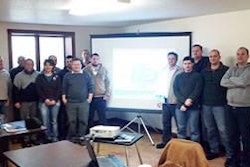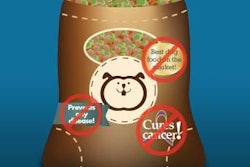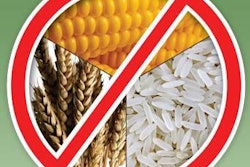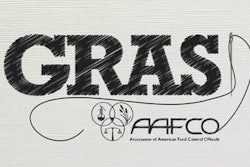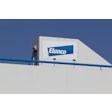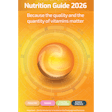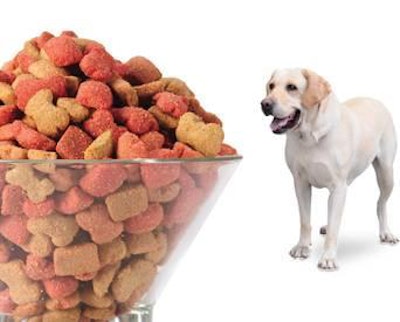
Many petfood companies stress the importance of meat-first formulations. The implication to consumers is that these diets are better for their pets. However, meat-first diets may result in overages for a number of nutrients, especially protein, fat, calcium and phosphorus (Table 1). In general, the higher the level of meat in a petfood, the higher the concentration of calcium, phosphorus, magnesium and certain micro-minerals.
Elevated calcium (Ca) and phosphorus (P) levels are common in petfood. Based on a survey of 58 wet and dry cat foods, Ca concentrations averaged 1.2%; P concentrations averaged 1.0%. Similarly, based on a survey of 70 wet and dry dog foods, Ca concentrations averaged 1.2%; P concentrations averaged 0.96%. (See a table of the survey results.) These values are similar to other published nutrient profiles for dog and cat food (SACNIV, 2000) and are double the recommendations by the Association of American Feed Control Officials (2012).
Elevated concentrations of calcium and phosphorus can have detrimental effects on bioavailability of trace minerals. The antagonistic effects of calcium and/or phosphorus are detrimental for iron (Monsen and Cook, 1976; Snedeker et al., 1982), manganese (O’Dell, 1989; Wedekind et al., 1991) copper (Shackelford et al., 1994) and especially zinc. Indeed, studies have demonstrated higher zinc requirements in dog foods containing high levels of calcium.
Robertson and Burns (1963) observed that puppies fed a typical diet containing 33 mg zinc/kg and 1.1% Ca developed a zinc deficiency, whereas puppies fed the same zinc level and lower calcium did not. Similarly, Sanecki et al. (1982, 1985) observed a zinc deficiency in puppies fed 20-35 mg zinc/kg and 2.64% Ca. Control puppies fed the same diet but supplemented with 120 mg zinc/kg grew normally with no signs of a zinc deficiency.
Reports of naturally occurring zinc deficiencies in growing dogs fed cereal-based, high-calcium petfoods have been documented (Nutrient Research Council, 2006). Association of American Feed Control Officials recommendations for dogs (e.g., 120 mg zinc/kg diet) are two-fold higher than the Nutrient Research Council (e.g., 60 mg zinc/kg), because of higher calcium levels present in some commercial dog foods (AAFCO, 2012).
The problem with feeding higher levels of zinc (or other trace minerals) is that these concentrations can negatively affect bioavailability of other micro-nutrients (e.g., iron, copper; O’Dell, 1989). A better option is to supplement petfoods with chelates to increase mineral bioavailability, thereby allowing lower inclusion rates. A recent study conducted by Richards et al. (2012) demonstrated four-fold greater zinc bioavailability for zinc chelated to methionine hydroxy analog relative to ZnSO4 in the presence of elevated Ca (1.2%) and P (1% available). Lowe et al. (1994) also demonstrated that zinc chelated with glycine, but not ZnO, was able to overcome antagonisms imposed by high calcium/phosphorus.
A number of possible mineral-mineral interactions is theoretically possible. Hill and Matrone (1970) proposed that elements whose physical and chemical properties are similar will act antagonistically. While structure and valence have proven to be useful to predict which minerals would be negatively affected by each other, it does not explain all of the observed nutritional interactions (Figure 1).
Excess macro-minerals increase risk for a number of dog and cat diseases. For example, phosphorus restriction (and protein) slows the progression of kidney disease. Because detection of kidney disease in early stages is difficult, avoiding phosphorus excess is recommended for preventing kidney disease (Jacob et al., 2002; Ross et al., 2006).
Restriction of magnesium and phosphorus (and protein) is recommended for avoidance of struvite uroliths, whereas restriction of calcium and phosphorus is recommended for lowering risk of calcium oxalate stones (SACNV, 2010). Calcium (and energy) excess, together with rapid growth, predispose large-breed dogs to osteochondrosis and hip dysplasia (Hazewinkel et al., 1985; Meyer and Zentek, 1991). Interestingly, chelated trace minerals have been shown to decrease incidence of tibial dyschondroplasia (lameness) in turkeys (Dibner et al., 2006).
Elevated trace mineral concentrations are also common in petfoods relative to AAFCO recommendations. Selenium and iodine concentrations are especially high in wet feline diets containing fish or seafood (e.g., 10-20 times minimum recommendations; Wedekind et al., 2010). Iodine is high in some canine wet diets.
In people, 10 times the recommended iodine intake can cause thyroid dysfunction (Pennington, 1990). A link between selenium, iodine and thyroid disease in dogs or cats has not been proven, but both minerals are involved in the metabolism of triiodothyronine (T3) and thyroxine (T4) thyroid hormones (Figure 2).
A number of epidemiological studies indicate greater incidence of hyperthyroidism in cats consuming wet foods—a two- to four-fold higher incidence in cat populations consuming wet foods relative to cats consuming dry foods only (Scarlett et al., 1988; Kass et al., 1999; Martin et al., 2000; Edinboro et al., 2004; Olczak et al., 2005). Higher selenium and iodine concentration may be risk factors that increase prevalence of hyperthyroid disease.
High iron and copper concentrations are also of concern, because both can be pro-oxidants at high concentrations. Ionic copper and iron readily participate in the Fenton reaction that results in production of reactive oxygen species. Free radicals may cause lipid peroxidation in vivo—damaging cell membranes, nucleic acids and oxidizing cellular protein—and may also reduce shelf life of extruded petfoods (Draper, 1988; Zicker et al., 2006).
Meat-first diets may not be what’s best for pets, because these diets often contain excesses of protein, fat and minerals. In light of the advancing age of the pet population, optimal nutrition should aim for a balanced diet without nutrient excesses.


